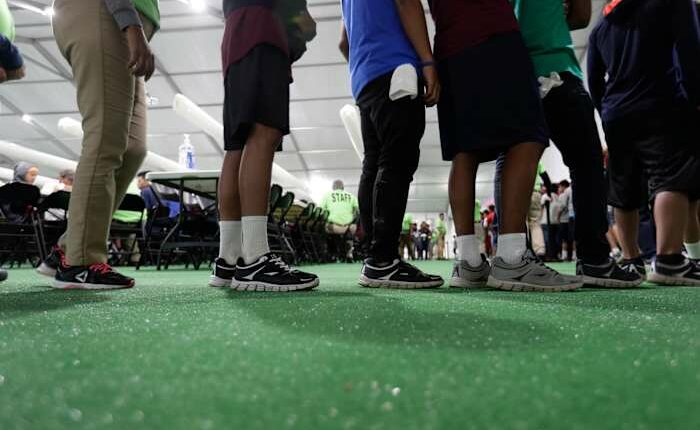Share this @internewscast.com

A federal judge has temporarily halted a new Trump administration measure aimed at keeping migrant children in detention after they reach 18, moving swiftly to prevent their transfer to adult facilities that advocates claimed were planned for this weekend.
U.S. District Judge Rudolph Contreras issued a temporary restraining order on Saturday, directing U.S. Immigration and Customs Enforcement not to hold any child who arrived in the country unaccompanied and without permission in ICE adult detention centers upon reaching adulthood.
The Washington, D.C., judge found that such automatic detention violates a court order he issued in 2021 barring such practices.
ICE and the U.S. Department of Homeland Security didn’t immediately respond Saturday to emails seeking comment.
The initiative to detain these individuals as adults marks another conflict over a highly sensitive aspect of President Donald Trump’s stringent immigration policies — the handling of children crossing the border without adult guardianship.
The Associated Press reported Friday that authorities are offering migrant children aged 14 and above $2,500 to voluntarily return to their countries of origin. Last month, a different federal judge stopped efforts to immediately deport Guatemalan migrant children who arrived in the U.S. alone back to their homeland. Some children were already boarded on planes during a nighttime operation before it was blocked by a judge.
“All of these are facets of a broad policy to pressure immigrant youth into relinquishing their right to seek protection in the United States,” stated Michelle Lapointe, a lawyer for the American Immigration Council, one of the organizations urging Contreras to take action in a filing submitted just after midnight on Saturday.
Unaccompanied children are housed in shelters managed by the Office of Refugee Resettlement, which is part of the U.S. Health and Human Services Department, not ICE. Contreras’ 2021 order directed federal officials to release minors turning 18 from these shelters to “the least restrictive setting available.” He determined that federal law mandates this, provided the minor isn’t a danger to themselves or others and isn’t a flight risk. Minors are typically released to a relative’s custody or possibly into foster care.
But lawyers who represent unaccompanied minors said they began getting word in the last few days that ICE was telling shelters that children who were about to turn 18 — even those who had already-approved release plans — could no longer be released and would instead be taken to detention facilities, possibly as early as Saturday. One email from ICE asserted that the new adults could only be released by ICE under its case-by-case parole authority for “urgent humanitarian reasons” or “significant public benefit.” From March through September, ICE has paroled fewer than 500 people overall.
The plaintiffs argued that “release on parole is all but a dead letter” and that children aging out of shelters would experience lasting harm from “unnecessary and inappropriate adult detention” in jails that might be overcrowded or in remote locations. The plaintiffs said that was especially true because some of the clients they cited had been victims of trafficking or had been abused, neglected or abandoned by their parents.
U.S. border authorities have arrested children crossing the border without parents more than 400,000 times since October 2021. A 2008 law requires them to appear before an immigration judge before being returned to their countries.
Children have been spending more time in government-run shelters since the Trump administration put them under closer scrutiny before releasing them to family in the United States to pursue their immigration cases.
The additional scrutiny includes fingerprinting, DNA testing and home visits by immigration officers. Over the summer, immigration officers started showing up and arresting parents.
The average length of stay at government-run shelters for those released in the U.S. was 171 days in July, down from a peak of 217 days in April but well above 37 days in January, when Trump took office.
Copyright 2025 The Associated Press. All rights reserved. This material may not be published, broadcast, rewritten or redistributed without permission.











